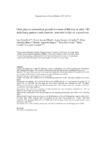Oral glucose-stimulated growth hormone (GH) test in adult GH deficiency patients and controls: potential utility of a novel test

Ver/
Use este enlace para citar
http://hdl.handle.net/2183/19669
A non ser que se indique outra cousa, a licenza do ítem descríbese como Creative Commons Attribution-NonCommercial-NoDerivs 4.0 International License (CC-BY-NC-ND 4.0)
Coleccións
- GI-FENM - Artigos [117]
- INIBIC-EENM - Artigos [52]
Metadatos
Mostrar o rexistro completo do ítemTítulo
Oral glucose-stimulated growth hormone (GH) test in adult GH deficiency patients and controls: potential utility of a novel testAutor(es)
Data
2017-06-09Cita bibliográfica
Pena-Bello L, Seoane-Pillado T, Sangiao-Alvarellos S, Outeiriño-Blanco E, Varela-Rodriguez B, Juiz-Valiña P, Cordido M, Cordido F. Oral glucose-stimulated growth hormone (GH) test in adult GH deficiency patients and controls: potential utility of a novel test. Eur J Intern Med. 2017 Oct;44:55-61.
Resumo
[Abstract] Context. The diagnosis of adult GH deficiency requires confirmation with a GH stimulation test. Oral glucose (OG) administration affects GH secretion, initially decreasing and subsequently stimulating GH secretion.
Objective. The aim of this study was to investigate the diagnostic efficacy and safety of a long OG test (LOGT) as a stimulus of GH secretion for the diagnosis of adult GH deficiency (AGHD).
Design. Prospective experimental cross-sectional study.
Settings. The study was conducted at the Endocrinology department of the University Hospital of a Coruña, Spain.
Participants and methods. We included 60 (40 women) AGHD patients (15) and controls (45) paired 1:3, of similar age, sex and BMI. The area under the curve (AUC) and peak were calculated for GH. The Mann-Whitney test was used to compare the different groups. ROC curve analyses were used. p-Values < 0.05 were considered as statistically significant.
Interventions. The intervention consisted of orally administering 75 g oral glucose administration; GH was obtained every 30 min for a total of 300 min.
Main outcome measurement. Peak GH area under receiver operating characteristic curve (ROC-AUC) following LOGT.
Results. Peak GH (μg/L) levels were lower in the AGHD patients (0.26 ± 0.09) than in the controls (4.00 ± 0.45), p < 0.001. After LOGT, with the ROC plot analysis the best peak GH cut-point was 1.0 μg/L, with 100% sensitivity, 78% specificity, ROC-AUC of 0.9089 and 81.82% accuracy. There were no relevant adverse events during any of the LOGT.
Conclusions. The LOGT could be a cheap, safe, convenient and effective test for the diagnosis of AGHD.
Palabras chave
GH
Glucose
Stimulation
Test
Glucose
Stimulation
Test
Versión do editor
Dereitos
Creative Commons Attribution-NonCommercial-NoDerivs 4.0 International License (CC-BY-NC-ND 4.0)
ISSN
0953-6205
1879-0828
1879-0828






